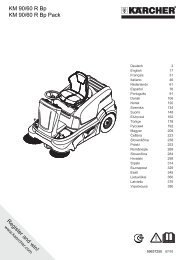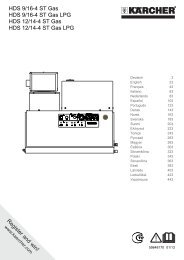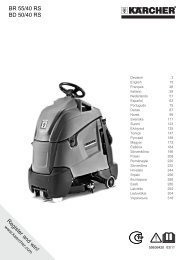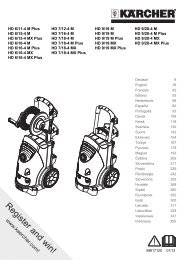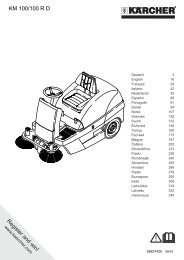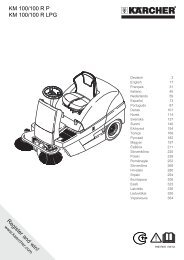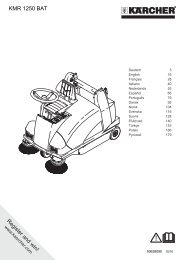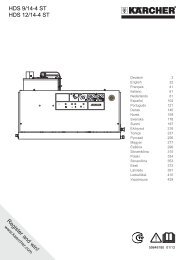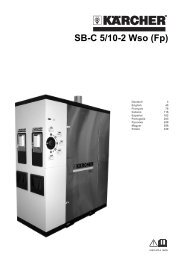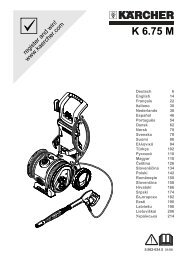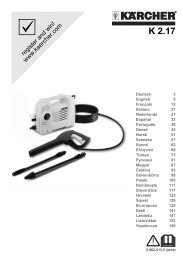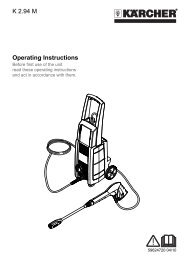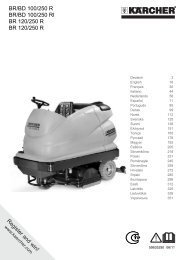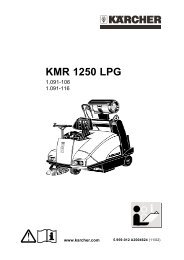- Page 1: Register and win! www.kaercher.com!
- Page 4 and 5: - BImSchV: Verordnung zur Durchfüh
- Page 6 and 7: Gefahr Verletzungsgefahr! Gerät, Z
- Page 8 and 9: Verschmutzung - Reinigungsmittel er
- Page 10 and 11: Minimale Wassersäule, Siphon Zulas
- Page 12 and 13: Mit dem zuständigen Kärcher-Verka
- Page 14 and 15: Störung Mögliche Ursache Behebung
- Page 16 and 17: ! - Die Heizeinrichtung des Geräte
- Page 18 and 19: - Die Isolation der Rohrleitung mus
- Page 20 and 21: Bild 17 20 Deutsch Installationsmat
- Page 22 and 23: Hiermit erklären wir, dass die nac
- Page 24 and 25: The work station is located at the
- Page 26 and 27: Danger Risk of injury! Device, tube
- Page 28 and 29: Dirt Nozzle Spray an- Part no. Pres
- Page 30 and 31: Connectiing piece DN 40 (HTR) 40 (H
- Page 32 and 33: You can enter into a maintenance co
- Page 34 and 35: Fault Possible cause Remedy of whom
- Page 38 and 39: - The insulation of the pipes must
- Page 40 and 41: Figure 17 40 English Installation m
- Page 42 and 43: We hereby declare that the machine
- Page 44 and 45: - Seul des monteurs du SAV Kärcher
- Page 46 and 47: Danger Risque de blessure ! L'appar
- Page 48 and 49: Salissure Buse Angle de projection
- Page 50 and 51: Raccordement DN 40 (HTR) 40 (HTR) 4
- Page 52 and 53: Un contrat de maintenance pour l'ap
- Page 54 and 55: Panne Eventuelle cause Remède Par
- Page 56 and 57: ! - Le dispositif de chauffage de l
- Page 58 and 59: - L'isolation du tuyautage doit êt
- Page 60 and 61: Figure 17 60 Français Matériel d'
- Page 62 and 63: Nous certifions par la présente qu
- Page 64 and 65: - DIN 13384-1: calcoli delle dimens
- Page 66 and 67: Pericolo Rischio di lesioni! L' app
- Page 68 and 69: Sporco Ugello Angolo di spruzzo HDS
- Page 70 and 71: Scarico condensa (max.) l/h 4 (medi
- Page 72 and 73: E' possibile stipulare un contratto
- Page 74 and 75: Guasto Possibile causa Rimedio Adde
- Page 76 and 77: ! - Il dispositivo di riscaldamento
- Page 78 and 79: Montare il contenitore del detergen
- Page 80 and 81: Fig. 17 80 Italiano Materiale per l
- Page 82 and 83: Con la presente si dichiara che la
- Page 84 and 85: - DVGW werkbladen: G260, G600, G670
- Page 86 and 87:
Gevaar Verwondingsgevaar! Apparaat,
- Page 88 and 89:
Bij meer dan 20 m buizen of meer da
- Page 90 and 91:
Aansluiting DN 40 (HTR) 40 (HTR) 40
- Page 92 and 93:
Met het bevoegde Kärcher-verkoopka
- Page 94 and 95:
Storing Mogelijke oorzaak Oplossing
- Page 96 and 97:
! - De verwarmingseenheid van het a
- Page 98 and 99:
- Als de buisleiding klaar is, moet
- Page 100 and 101:
Afbeelding 17 100 Nederlands Instal
- Page 102 and 103:
Hierbij verklaren wij dat de hierna
- Page 104 and 105:
- Ajustes, trabajos de mantenimient
- Page 106 and 107:
Peligro Peligro de lesiones El apar
- Page 108 and 109:
En el caso de una tubería de más
- Page 110 and 111:
Salida de condensado (máx.) l/h 4
- Page 112 and 113:
Se puede firmar un contrato de mant
- Page 114 and 115:
Avería Posible causa Modo de subsa
- Page 116 and 117:
! - El dispositivo calefactor del a
- Page 118 and 119:
- El aislamiento de la tubería tie
- Page 120 and 121:
Figura 17 120 Español Material de
- Page 122 and 123:
Por la presente declaramos que la m
- Page 124 and 125:
- DIN 1988: Regulamentos técnicos
- Page 126 and 127:
Perigo Perigo de lesões! O aparelh
- Page 128 and 129:
Sujidade Bocal Ângulo Refª Press
- Page 130 and 131:
Evacuação de condensado (máx.) l
- Page 132 and 133:
Existe a possibilidade de assinar u
- Page 134 and 135:
Avaria Possível causa Eliminação
- Page 136 and 137:
! - O equipamento de aquecimento da
- Page 138 and 139:
- O isolamento da tubagem deve ser
- Page 140 and 141:
Figura 17 140 Português Material d
- Page 142 and 143:
Declaramos que a máquina a seguir
- Page 144 and 145:
Arbejdspladsen er på betjeningspan
- Page 146 and 147:
Risiko Fysisk Risiko! Maskinen, til
- Page 148 and 149:
Tilsmudsning - Rensemidler letter r
- Page 150 and 151:
Tilslutning DN 40 (HTR) 40 (HTR) 40
- Page 152 and 153:
Der kan aftales en servicekontrakt
- Page 154 and 155:
Fejl Mulig årsag Afhjælpning Af h
- Page 156 and 157:
! - Maskinens opvarmningsindretning
- Page 158 and 159:
Opstille rensemiddelbeholderen Fig.
- Page 160 and 161:
Fig. 17 160 Dansk Installationsmate
- Page 162 and 163:
Hermed erklærer vi, at den nedenfo
- Page 164 and 165:
Arbeidsplassen er ved betjeningspan
- Page 166 and 167:
Fare! Fare for skader! Apparat, til
- Page 168 and 169:
Bilde 6 - Den ytre skalaen gjelder
- Page 170 and 171:
Tilkobling DN 40 (HTR) 40 (HTR) 40
- Page 172 and 173:
Du kan inngå en vedlikeholdsavtale
- Page 174 and 175:
Feil Mulige årsaker Retting av hve
- Page 176 and 177:
! - Varmeinnretningen på maskinen
- Page 178 and 179:
Montere beholder for rengjøringsmi
- Page 180 and 181:
Bilde 17 180 Norsk Installasjonsmat
- Page 182 and 183:
Vi erklærer hermed at maskinen ang
- Page 184 and 185:
- Bär lämpliga skyddskläder och
- Page 186 and 187:
Fara Risk för skador! Aggregat, ma
- Page 188 and 189:
Bild 6 - Den yttre skalan gäller v
- Page 190 and 191:
Anslutning DN 40 (HTR) 40 (HTR) 40
- Page 192 and 193:
Med ansvarig Kärcher-försäljning
- Page 194 and 195:
Störning Möjlig orsak Åtgärd av
- Page 196 and 197:
! - Aggregatets värmeanordning är
- Page 198 and 199:
Uppställning rengöringsmedelsbeh
- Page 200 and 201:
Bild 17 200 Svenska Installeringsma
- Page 202 and 203:
Härmed försäkrar vi att nedanst
- Page 204 and 205:
- Käytä sopivia suojavaatteita ja
- Page 206 and 207:
Vaara Loukkaantumisvaara! Laitteen,
- Page 208 and 209:
Jos putken pituus on enemmän kuin
- Page 210 and 211:
Liitäntä DN 40 (HTR) 40 (HTR) 40
- Page 212 and 213:
Voit tehdä huoltosopimuksen laitte
- Page 214 and 215:
Häiriö Mahdollinen syy Korjaus su
- Page 216 and 217:
! - Laitteen kuumennusyksikkö on k
- Page 218 and 219:
Pesuainesäiliöiden sijoitus Kuva
- Page 220 and 221:
Kuva 17 Koh ta 220 Suomi Asennettav
- Page 222 and 223:
Vakuutamme, että alla mainitut tuo
- Page 224 and 225:
- Η εγκατάσταση αγω
- Page 226 and 227:
Κίνδυνος Κίνδυνος
- Page 228 and 229:
Ρύποι Ακροφύσ ιο HDS
- Page 230 and 231:
Σύνδεση DN 40 (HTR) 40 (HTR)
- Page 232 and 233:
Μπορείτε να συνάψε
- Page 234 and 235:
Βλάβη Πιθανό αίτιο
- Page 236 and 237:
! - Η διάταξη θέρμαν
- Page 238 and 239:
- Η πτώση της πίεσης
- Page 240 and 241:
Εικόνα 17 Θέσ η 240 Ελ
- Page 242 and 243:
Δια της παρούσης δη
- Page 244 and 245:
- Согласно настоящи
- Page 246 and 247:
Рис. 1 1 горелку, 2 Ма
- Page 248 and 249:
Поврежденный высок
- Page 250 and 251:
Выключатель прибор
- Page 252 and 253:
Подсоединение DN 40 (H
- Page 254 and 255:
С отделом сбыта фир
- Page 256 and 257:
Неполадка Возможна
- Page 258 and 259:
! - Нагревательным у
- Page 260 and 261:
требования, монтаж,
- Page 262 and 263:
Рис. 17 262 Руccкий Мон
- Page 264 and 265:
Заявление о соотве
- Page 266 and 267:
- DIN 13384-1: Kéményméretek sz
- Page 268 and 269:
Veszély Sérülésveszély! A kés
- Page 270 and 271:
Szennye ződés HDS 9/16 erős 0006
- Page 272 and 273:
Csatlakozás DN 40 (HTR) 40 (HTR) 4
- Page 274 and 275:
Az illetékes Kärcher-kereskedőve
- Page 276 and 277:
Üzemzavar Lehetséges ok Elhárít
- Page 278 and 279:
! - A készülék melegítő berend
- Page 280 and 281:
- A csővezeték szigetelésének 1
- Page 282 and 283:
17. ábra 282 Magyar Installációs
- Page 284 and 285:
Ezennel tanúsítjuk, hogy az aláb
- Page 286 and 287:
- Za účelem ochrany před odstři
- Page 288 and 289:
Pozor! Nebezpečí poranění Pří
- Page 290 and 291:
Znečiště Tryska Úhel Č. dílu
- Page 292 and 293:
Připojení DN 40 (HTR) 40 (HTR) 40
- Page 294 and 295:
S příslušným prodejním odděle
- Page 296 and 297:
Porucha Možná příčina Odstran
- Page 298 and 299:
! - Topné zařízení přístroje
- Page 300 and 301:
- Izolace potrubí musí být teplo
- Page 302 and 303:
Obr. 17 302 Čeština Instalační
- Page 304 and 305:
Tímto prohlašujeme, že níže oz
- Page 306 and 307:
- Za zaščito pred brizganjem vode
- Page 308 and 309:
Nevarnost Nevarnost poškodb! Napra
- Page 310 and 311:
Onesnaž Šoba Brizgalni Št. dela
- Page 312 and 313:
Priključek DN 40 (HTR) 40 (HTR) 40
- Page 314 and 315:
S pristojno Kärcher prodajalno lah
- Page 316 and 317:
Motnja Možen vzrok Odprava Izvajal
- Page 318 and 319:
! - Ogrevalnik naprave je gorilna n
- Page 320 and 321:
Namestitev posode za čistilo Slika
- Page 322 and 323:
Slika 17 322 Slovenščina Inštala
- Page 324 and 325:
S to izjavo potrjujemo, da spodaj o
- Page 326 and 327:
- Instalacja przewodów gazowych ja
- Page 328 and 329:
Niebezpieczeństwo Ryzyko obrażeń
- Page 330 and 331:
W przypadku rur o długości powyż
- Page 332 and 333:
Upust kondensatu (maks.) l/h 4 (pop
- Page 334 and 335:
Z właściwym biurem sprzedaży fir
- Page 336 and 337:
Usterka Możliwa przyczyna Usuwanie
- Page 338 and 339:
! - Urządzenie grzewcze tego urzą
- Page 340 and 341:
Ustawianie zbiornika środka czyszc
- Page 342 and 343:
Rys. 17 342 Polski Materiał instal
- Page 344 and 345:
Niniejszym oświadczamy, że okreś
- Page 346 and 347:
- DIN EN 1443, DIN 18160 T1: Zariad
- Page 348 and 349:
Nebezpečenstvo Nebezpečenstvo por
- Page 350 and 351:
S potrubím dlhším ako 20 m alebo
- Page 352 and 353:
Minimálny vodný stĺpec, sifón P
- Page 354 and 355:
S kompetentným predajným miestom
- Page 356 and 357:
Porucha Možné príčiny Odstráne
- Page 358 and 359:
! - Ohrievacie zariadenie prístroj
- Page 360 and 361:
Inštalácia nádrže na čistiaci
- Page 362 and 363:
Obrázok 17 362 Slovenčina Inštal
- Page 364 and 365:
Týmto vyhlasujeme, že ďalej ozna
- Page 366 and 367:
- Kaitseks tagasipritsiva vee ja mu
- Page 368 and 369:
Oht Vigastusoht! Seade, toitekaabli
- Page 370 and 371:
Joonis 6 - Väline skaala kehtib, k
- Page 372 and 373:
Ühendus DN 40 (HTR) 40 (HTR) 40 (H
- Page 374 and 375:
Pädeva Kärcheri müügikontoriga
- Page 376 and 377:
Rike Võimalik põhjus Kõrvaldamin
- Page 378 and 379:
! - Seadme küttemehhanism kujutab
- Page 380 and 381:
Puhastusaine paagi paigaldamine Joo
- Page 382 and 383:
Joonis 17 382 Eesti Installatsiooni
- Page 384 and 385:
Käesolevaga kinnitame, et allpool
- Page 386 and 387:
- DIN 13384-1: Skursteņu izmēru a
- Page 388 and 389:
Briesmas Savainošanās risks! Ier
- Page 390 and 391:
Netīrība Sprausla Smidzinā šana
- Page 392 and 393:
Savienojums DN 40 (HTR) 40 (HTR) 40
- Page 394 and 395:
Ir iespējams noslēgt līgumu ar f
- Page 396 and 397:
Darbības traucējums Iespējamais
- Page 398 and 399:
! - Aparāta apsildes iekārta ir a
- Page 400 and 401:
Tīrīšanas līdzekļa tvertņu uz
- Page 402 and 403:
17. attēls 402 Latviešu Instalāc
- Page 404 and 405:
Ar šo mēs paziņojam, ka turpmāk
- Page 406 and 407:
Darbo vieta yra valdymo lauke. Kito
- Page 408 and 409:
Pavojus Sužalojimų pavojus! Priet
- Page 410 and 411:
Užterštu mas - Valymo priemonės
- Page 412 and 413:
Jungtis DN 40 (HTR) 40 (HTR) 40 (HT
- Page 414 and 415:
Su atsakingu Kärcher pardavimo biu
- Page 416 and 417:
Gedimas Galimos priežastys Šalini
- Page 418 and 419:
! - Prietaiso šildymo sistema yra
- Page 420 and 421:
Valymo priemonių bako pastatymas 1
- Page 422 and 423:
17 paveikslas 422 Lietuviškai Įre
- Page 424 and 425:
Šiuo pareiškiame, kad toliau apra
- Page 426 and 427:
Çalışma yeri, kumanda panosundad
- Page 428 and 429:
Tehlike Yaralanma tehlikesi! Cihaz,
- Page 430 and 431:
Resim 6 - Dıştaki çizelge, incel
- Page 432 and 433:
Minimum su sütunu, sifon Ruhsat EN
- Page 434 and 435:
Yetkili Kärcher satış ofisi ile
- Page 436 and 437:
Arıza Olası nedeni Arızanın gid
- Page 438 and 439:
! - Cihazın ısıtma tertibatı bi
- Page 440 and 441:
Soket/fişle elektrik bağlantısı
- Page 442 and 443:
Resim 17 442 Türkçe Kurulum malze
- Page 444 and 445:
İşbu belge ile aşağıda tanıml
- Page 446 and 447:
- Операційна таблиц
- Page 448 and 449:
Обережно! Небезпек
- Page 450 and 451:
Забрудне ння HDS 9/16 с
- Page 452 and 453:
Відвід конденсату (
- Page 454 and 455:
Можна заключити до
- Page 456 and 457:
Несправність Можли
- Page 458 and 459:
! - Нагрівальним при
- Page 460 and 461:
- Готовий трубопров
- Page 462 and 463:
Мал. 17 462 Українська
- Page 464:
Заява про відповід



